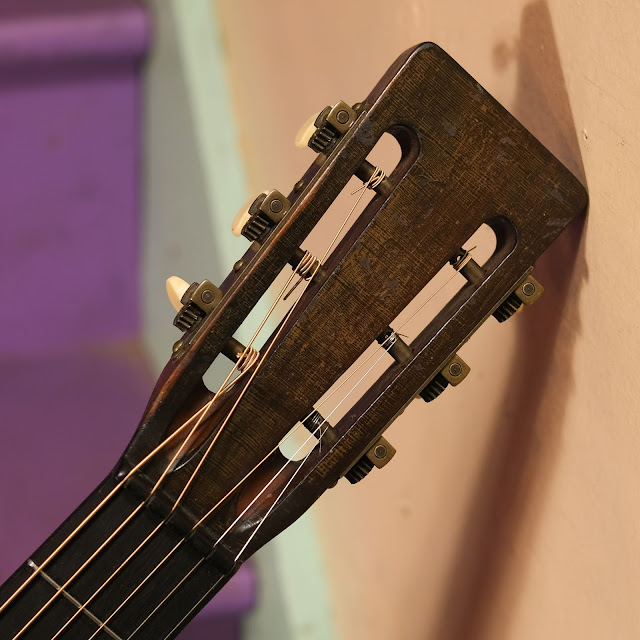1930 Martin 0-18 Flattop Guitar
My friend Tom has owned this gorgeous old Martin since 2011 when its owner sold it directly to him. Tom plays his guitars hard and takes them all over the place, so I've had an opportunity to keep an eye on this thing the whole time. I'd mentioned some time back that it could use some extra work to get it to play its best and he finally relented and I got it turned-around for him.
Tom's a wonderful fingerpicker and songster, so an instrument like this is almost purpose-built for his playing style. It's very warm, full, and sweet -- but with a good amount of volume -- and so it makes a great foil for his brighter, more-aggressive picking style. They end-up meeting in the middle and the two of them make some good music together.
Martin flattops from this era are basically not steel-string guitars yet. They want to be, but they're built exceedingly-light and tend to have the normal issues of lightly-built guitars. They're a bit unstable and, season to season, an owner might need 3 or 4 different-height saddles and various shims so he or she can keep the action where it's wanted. The top will get a belly no matter what you do, and if you don't keep an eye on them, they can get decrepit.
This guy was certainly a bit decrepit by the time it got back here for an overhaul. Its flat-bottomed replacement bridge had conformed to the top's desire to belly-up and is now shaped like an old bridge on the bottom (a light arc). The original bar frets had been played nearly into the board and the neck had some decent relief (warp) in it. The old hairline cracks had come undone and one of the main x-braces actually had a split half-way down its length on the lower-bout. The action was OK but there was a lot of buzzing as one approached the fretboard extension. Yep -- all lightly-built, scallop-braced, thin-skin guitar stuff.
But, ya know, the sound, right? Everyone who's heard this guitar (and other early-'30s Martins) always goes right for the meat of that matter -- the sound. They have it.
Per Style 18 appointments, it has a solid spruce top with extra-light, scalloped bracing (it should be a classical guitar, hah hah), solid mahogany back and sides, mahogany neck with ebony rod reinforcement, ebony fretboard and bridge, and rosewood headstock veneer. The binding is rosewood.
Repairs included: brace repairs, cleats for cracks, a board plane and re-install (shimmed-up slightly) of the original bar frets, difficult level/dress/fret-seating job, cleaning, and a good setup. Previous repairs included a replacement (parts-bin) ebony bridge as well as various saddles and new, StewMac repro-style aged tuners.
Setup notes: action is bang-on at 3/32" EA and 1/16" DGBE height at the 12th fret, strung with 46w-10 extra lights. The neck is straight and the guitar's been stable for a week and seems happy. Tom has plenty of saddles and shims to deal with winter changes, however...
Condition notes: it's been played hard and Tom's put a lot of miles on it. Check out the original 2011 blog post to see what I mean. It was beat, then, but the love this guitar has received... you can see it on the back of the neck and the lower-bout-top.

















Comments